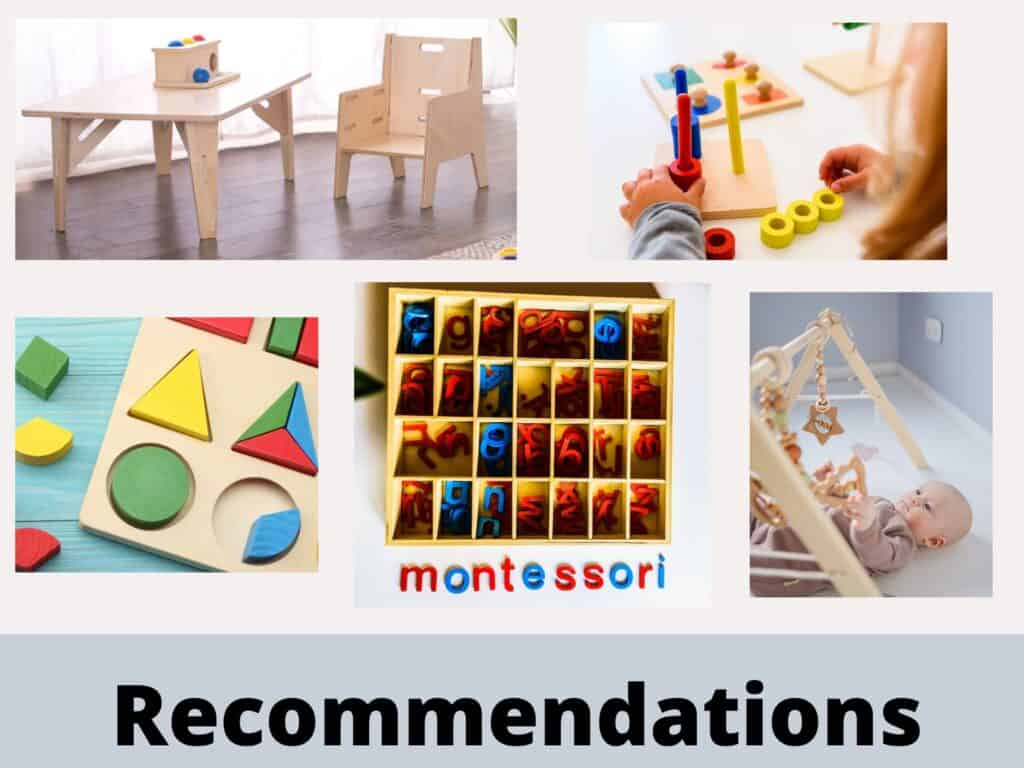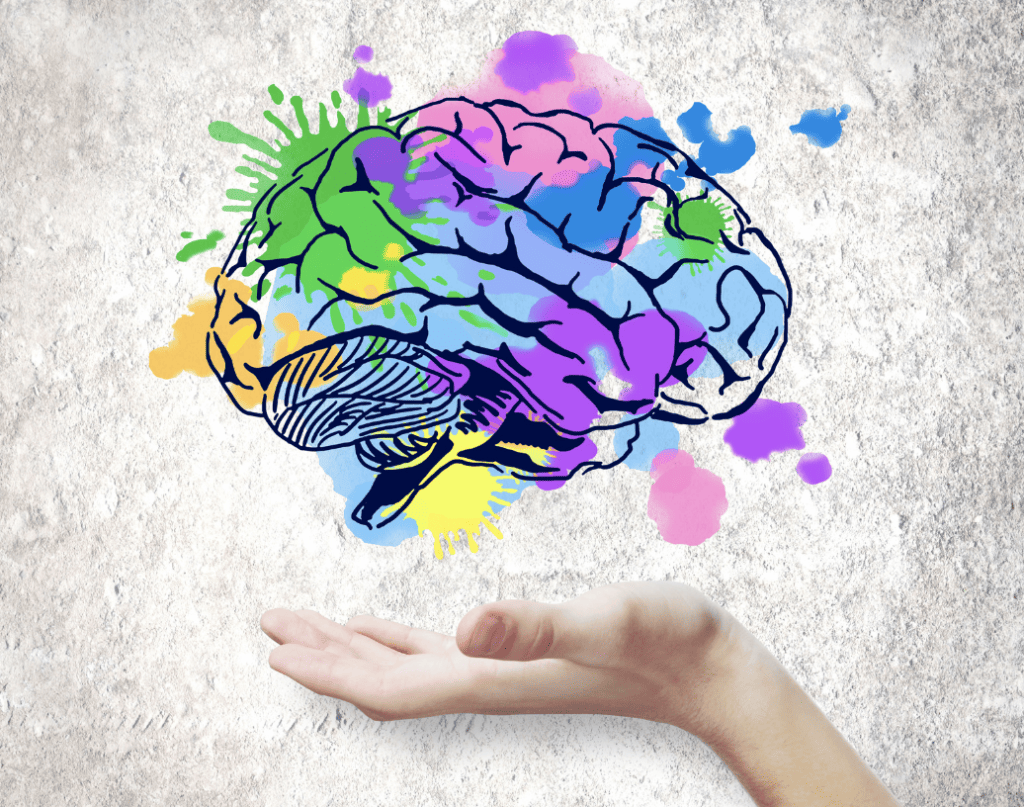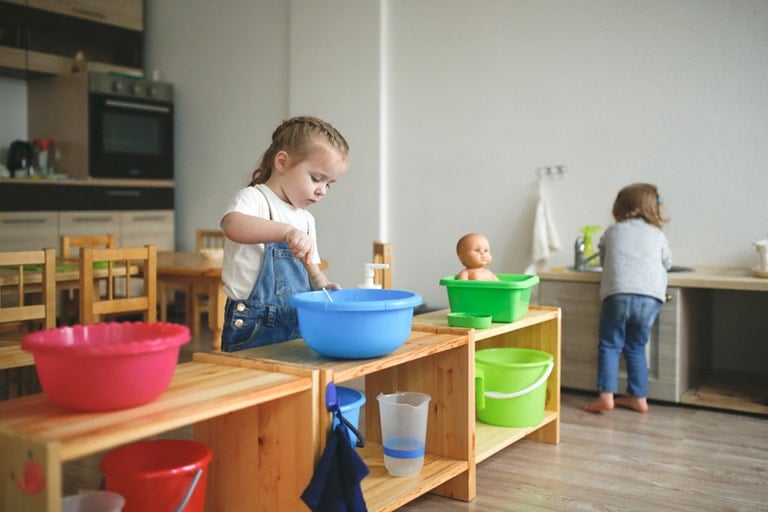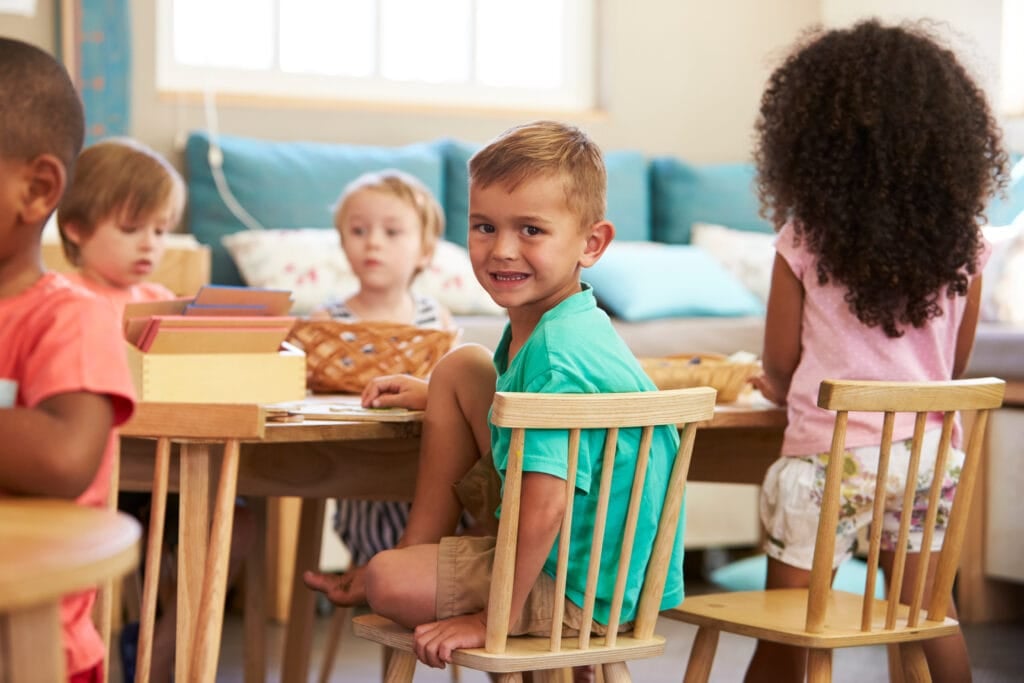Montessori educators discourage children from engaging in fantasy play, eschewing it instead for play based in reality. It recognizes, however, that imagination is a critical part of a child’s ability to learn and grow as well as being a foundation for human creativity.
Many parents and people cringe when they’re first exposed to the
So What are Montessori ‘s Views on Pretend Play?
Many people think
Younger children are often more fascinated with what they discover in the real world, so a
Another great example is having a functional kitchen instead of a pretend play kitchen.
These practices change by developmental plane, a brief summary of which is listed in the table below.
| Developmental Plane | Brief Description |
| 1st (Toddler-6 yrs.) | Child’s mind is absorbent, ready to learn, strong desire to be physically independent |
| 2nd (6 yrs.-12 yrs.) | Child is moving towards mental independence, ready to start understanding more abstract concepts |
| 3rd (12 yrs.-18 yrs.) | Adolescent begins to understand their place in the world and to take more control over their life |
| 4th (18 yrs.-24 yrs.) | Adult ready to move on and take charge of their own life, developed a life-long love for learning |
In each of these planes, the child is encouraged to direct their own discovery of the world and their place in it, and to develop practical skills and knowledge. As the child gets older and is better able to distinguish reality from fantasy, toys, books, and games that land more solidly in the fantasy camp can be made available.
Montessori does not discourage playing pretend. She understand that pretend play is a crucial component of developing a child’s imagination, the center of their creativity. However, pretend play should involve things that are grounded in reality.
Montessori ‘s Views on Fantasy Play
For very young children, there isn’t an inborn ability to distinguish fantasy from reality. For this reason, Montessorians generally discourage fantasy stories, shows, and play. The following things are examples of what might be discouraged for young children in the first developmental stage:
- Stories with talking animals
- Movies or TV shows with superheroes
- Toys that move or act on their own
- Fantasy-based stuffed animals (like unicorns)
The method fully acknowledges that young children’s imaginations are extraordinarily active, and they’re not trying to suppress it at all. On the contrary, the real world is so brand new to young children that it’s just as fantastic as many fictional stories.
Fantasy is less discouraged as children age. In the
As children get older,
Learning Through all the Senses
Another crucial component is encouraging learning and exploration of the real-world through all the senses, not just through sight and sound (which are traditionally the most catered-to senses in other educational models). Children are encouraged to explore nature, play and learn in the classroom through touch, taste, and smell as well.
Therefore, some of the best toys for parents wanting to use the Montessori method are those made from natural materials that encourage kids to manipulate them by hand and engage multiple senses.
Montessori classrooms are set up to encourage frequent movement and exploration as well. At first, they may seem chaotic, but eventually an observer realizes that there is an order to the chaos as children move freely about the room to explore and concentrate on what fascinates them.
Montessori and a Kid’s Imagination
The
Therefore, effective educational, and parenting techniques, encourage the use of a child’s imagination in reality-based play and exploration. At very young ages, children’s play is very imaginative, as they carry out pretend scenarios and interactions that they see the adults in their lives do.
Dr. Montessori ’s Five Great Lessons
In the second plane of development, Dr.
| Lesson Number | Name | Description |
| 1st Great Lesson | Coming of the Earth and Universe | Describes the formation of the Earth and the mysteries of the cosmos |
| 2nd Great Lesson | Coming of Life | Introduction to biology and the study of life |
| 3rd Great Lesson | Humans Come to Earth | Study of human evolution and history |
| 4th Great Lesson | Communication and Writing | Introduction to history, mythology, and communication |
| 5th Great Lesson | Numbers | Introduction to math and numbers |
Because of the huge, abstract concepts each of these lessons introduces, an engaged and active imagination is essential as students begin to grapple with these questions and theories. It is especially important because these lessons all attempt to illustrate how everything on Earth and in the universe is ultimately interconnected.
Imagination and Its Role in Development
At its core, the
Because of the strong link between imagination and intelligence, there is no reason why
Using Imagination to Understand the World
Montessori models emphasize the use of imagination to help children understand the world around them, but imagination that’s grounded in reality. Consider trying to explain how a plane works to a young child, who might be able to see a plane in the sky but doesn’t understand the science.
A
Creativity’s Role in the Montessori Paradigm
Closely related to imagination is a child’s ability to be creative. Imagination allows a child to come up with alternate ways to understand the world around them, and to visualize new ways to solve problems, so it logically follows that an imaginative child will be creative as well.
When kids enter the second developmental plane, their imagination is prepared to help them understand abstract or advanced concepts that they couldn’t experience as a younger child. Since children at the age of 6 are better prepared to understand these advanced concepts, largely due to their well-developed imagination, they’re ready for the
These great lessons have already been described, but it’s useful to explain the role that creativity and imagination have. A healthy sense of creativity allows children to apply real-world experiences to abstract concepts more effectively than if they’re confused by years of exposure to fantasy.
In the words of Dr.Montessori , in order to light a fire of excitement for learning, the instruction must touch their imagination. Since aMontessori education is intended to create a life-long love of learning in children, it’s necessary to get them excited to learn. This is done through imagination and creativity in theMontessori model.
Creativity and Self-Direction
Since kids are largely responsible for choosing the direction of their own development (within wide boundaries set by their teacher), they must be in touch with their creative sides. This creativity allows them to think about things in new ways, come up with new approaches to problems, and to think outside the box.
Creativity helps children imagine what could possibly be so they actually become interested in what they’re learning. A Montessorian would say that schools that teach in a more traditional way stifle a child’s creativity because they keep them all in the same small box of instruction. There isn’t any room for a child to explore things that interest them.
Creativity in a Traditional School Setting
In a generic public-school setting, there isn’t much opportunity for a child to be creative outside of a few elective subjects, like art (and even then, projects are assigned to all children and they have little ability to choose their own directions). There’s a set lesson plan and even a set way to arrive at the answer, and children aren’t able to explore at their own pace.
According to a recent Gallup study, children who were placed in classrooms that encouraged creativity and used technology to help facilitate that creativity scored higher on five cognitive abilities than kids who were in environments that didn’t encourage creativity. These abilities were:
- Engaging in problem-solving
- Demonstrating critical thinking
- Retaining what they have learned
- Making connections between different subjects
- Having deep learning of subject matter
Clearly Montessorians are on to something with their emphasis on creativity; creative kids are able to better demonstrate critical thinking and exhibit problem-solving behaviors than less creative kids, and form connections between topics that leads to better learning and material retention.
Aligned Toys, Games, and Books
So, if you can’t buy plush toy monsters or get fantasy books for your children, what sorts of toys and games are approved by the
- Based in reality: Books for toddlers should be about situations that exist in the real world to promote a healthy ability to separate fantasy from reality
- Made from natural materials:
Ideally toys should have a multitude of different textures from real materials, like wood, metal, and natural fabrics, not plastic - Functional: Montessori toys should have a point to them, a concrete thing about the world that they teach young children.
- Toys are simple: they don’t have a lot of complicated pieces. A puzzle with three shapes helps a child learn through small bits of easy-to-understand information
- Limited choices: toys that are overly complex, or a simple overabundance of choices for toys, leads to kids feeling overwhelmed and frustrated.
Ever wonder why kids will usually just play with the box a new toy came in? It may be frustrating for the parents who spent all that money on the new toy, but it’s perfectly understandable. They are drawn to simple toys that they can learn about the world with; like a cardboard box.
Following you’ll find some examples of great toys, games, and books available on Amazon. If you follow the guidelines above and try and find things that fit within them for your child, you’ll be helping them learn about their world and develop their imagination and creativity.
Toys
Wooden Reading Blocks: A simple toy that teaches kids how to make a variety of three-letter words, these blocks are made from wood, feature only a couple moving parts, and have limited bright colors to help toddlers and young-uns learn about shapes and letters.
Carrot Size Sorting Puzzle: This toy will teach children how to sort items based on shape and size as they try and get the carrots back into the correct slots. Made from wood and painted with a limited variety of water-based paints, this item is perfect for a parent trying to buy
Toddler Sensory Busy Board: This board, while providing a variety of hands-on activities and textures for a busy toddler, will also help them learn and master important skills for dressing. This board includes belts, buttons, and zippers to help young children develop fine-motor skills that will let them dress themselves.
Games
Guess in 10 Game: This game teaches kids about the world in a fun series of questions. It’s based in reality so they’re learning all about animals while having fun.
MathDice Game: This simple dice game will help little ones explore basic addition and subtraction.
Beads and Pattern Card Sets: This set of beads, thread, and pattern cards will keep little ones occupied for hours while teaching colors, three-dimensional shapes, and pattern recognition skills.
Learning Cards Set: This set of learning cards helps teach young children phonics and letters while using pictures of real-world items, making it a solid item for any
Books
Set of 5 Nature Books: These books help introduce a variety of bugs and things that are found in nature in a way that young kids will love.
My First Book of Feelings: Kids can easily relate to stories about other children, and this book helps them learn about their emotions in a
My First Book of Numbers: This book uses fun illustrations of realistic things to teach kids all about numbers.
Shades of People: This book provides young children an early introduction to all the different races and colors of people in the world.
Do-It-Yourself Game, Toy, and Activity Ideas
Of course, you don’t need to spend a ton of money on games and toys off the internet or a store to give your kid fun, Montessori-aligned activities. Any activity that teaches through hands-on activities is a great way to bring your child some
- Water-pouring: kids love pouring and transferring water from one container to another, so filling up several different sized containers with water will help them understand volume as well as build fine motor skills.
- Washing activities: filling a bin with soapy water and giving a child a variety of toys to wash gives them different textures as well as teaching them real-life skills.
- Fill a small tray with decorative rocks to help little ones learn how to write letters and numbers.
- Use Velcro and a piece of felt to create sorting games with realistic pictures for little ones to sort; i.e. vegetables vs. fruits, living vs. non-living things, etc.
- Kids are naturally drawn to museums and zoos where they can see concrete example of history and real-life animals. Both places are set up for excellent educational experiences.
See also: Montessori Activities for Every Age
Further Reading
There are a number of excellent books designed to give parents an idea of the
- The Montessori Toddler by Simone Davies – $10-$20
- Montessori: The Science Behind the Genius by Angeline Stoll Lillard – $10-$19
- Montessori From the Start by Paula Polk Lillard and Lynn Lillard Jessen – $10-$15







